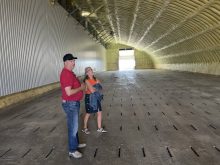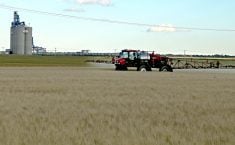Blake Jennings was nine when he first began growing pumpkins and has expanded his business over the last 20 years
MASSTOWN, N.S. — Harvest is a busy time for any farmer, but there is extra urgency to getting your product off the field when it is worthless on Nov. 1.
Blake Jennings was just nine years old when he established Blake’s Pumpkin Jungle on land next to the family poultry operation near the Bay of Fundy in Nova Scotia.
His father and grandfather had grown some pumpkins and squash for Co-op Atlantic, and young Blake, the fifth generation, tried gourds and then pumpkins to earn some money. He named his business “jungle” because he was tripping and falling over vines and decided that made more sense than “patch.”
Read Also

New coal mine proposal met with old concerns
A smaller version of the previously rejected Grassy Mountain coal mine project in Crowsnest Pass is back on the table, and the Livingstone Landowners Group continues to voice concerns about the environmental risks.
He’s now 30 with two young children of his own.

He started small, with two acres, and this year grew 85 acres of several varieties.
“We are one of the largest, if not the largest, in Atlantic Canada,” Jennings told Canadian farm writers on a recent tour.
“Maybe not in acres, but in pumpkins.”
The operation includes the roadside stand, which started it all, but also a wholesale business to large grocers.
“We ship mainly to Sobeys, directly to their warehouse, which is only eight minutes from here. We’ll ship probably 20 tractor trailers to them this year,” he said.
He also supplies pumpkins to nearby Masstown Market, Sobeys in Truro, farmers markets in Halifax and other farms and businesses in the Maritimes.
He employs six foreign workers, two full-time employees and other part-timers at this time of year.
After Halloween the staff falls to two full-time helpers.
“Everything gets hectic, but as long as the weather co-operates, we seem to get through it,” he said.
Pumpkin farming is a lot of manual labour.
All harvesting is done by hand, and until this year planting was done by hand, too.
Jennings ordered a new vacuum seeder from Europe that can plant any kind of vegetable, which will help with his plans to grow other crops.
He is trying to incorporate more crops to rotate his fields.
The one with the roadside stand hasn’t been rotated in 15 years but will be this year.
“It’s the spot that brings everybody in,” he said.
“We’ve been trying to acquire more land and we’re working with our cousins at the dairy farm next door to rotate a lot of land.”
That mainly involves corn for the dairy cattle. However, Jennings planted seven acres of sweet corn this year to ship to Sobeys and Masstown Market and plans to double that next year, which will also help.
Jennings said about 98 per cent of the pumpkins he grows are for ornamental purposes. There are a few squash varieties grown for food.
The roadside stand accounts for five to 10 per cent of sales but represents the fun of the business and the chance to talk to customers, he said.
They have to meet requirements for their other customers.
For Sobeys, they have to fill cardboard bins with 50 pumpkins each between nine and 14 inches.
They can load 52 or 56 of the cardboard bins on a trailer and will ship many trailer loads each season.
Jennings said even though he plants fields at different times, using new seed each year, it can be tough to predict when the pumpkins will be ready.
“The very last field I planted was ready two weeks ago and the field I planted two weeks before that one isn’t ready yet,” he said.
Inputs are minimal, but fertility relies heavily on the manure from the Jennings’ 16,000-layer barn. The manure is stockpiled and applied in spring.
“We use all of that and then probably 20 acres worth we put chemical fertilizer on because we don’t have enough hen manure,” he said.
“Then we do pre-emerge sprays after we plant before they sprout to help with weed control.”
Some varieties are treated for beetles, but no post-emergent herbicides are registered for pumpkins.
“Then you just sit down and you pray that the weather works and they grow,” Jennings said.

Last year was extremely wet, and his farm was one of the few that had some success.
“Last year was the best worst year ever,” he said.
“We sold every pumpkin we had but we lost probably 25 acres worth in all the rain.”
He attributes that success to planting in hills.
Still, in many fields more than half of the pumpkins were not harvested. Stem rot and powdery mildew can be problems in the damp. Pumpkins that aren’t harvested are tilled under and then disced to prevent volunteers from coming up.
Crop insurance is available but can be “finicky,” he said. He prefers to give clients what he can than nothing at all.
This year was hot and dry, resulting in smaller than usual pumpkins.
He also has to cope with deer, which prefer to take a bite out of several pumpkins rather than just eat one, and bears, which play with them.
Jennings calls his pumpkin business a labour of love. He also works at the poultry barn full time and expects to take it over some day.
He hopes his children will want to take on the pumpkin jungle.


















